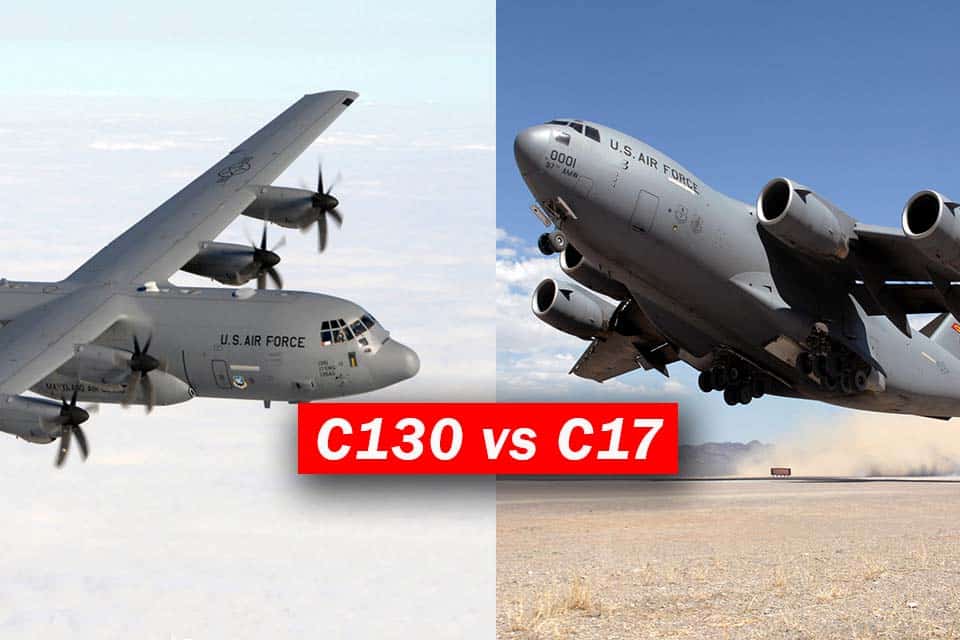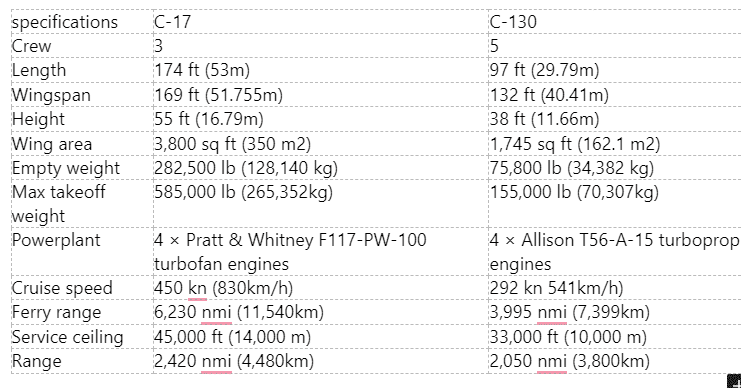Aviation
C-17 vs C-130 A Comparison of two Legends Military cargo planes.

In this article, the C130j Hercules freight plane and the C17 Globemaster passenger aircraft will be compared.
C-17 Globemaster
Boeing C-17 Globemaster III is a large military transport aircraft that was developed for the United States Air Force (USAF). On 15 September 1991, the first C-17 performed its maiden flight and formally entered USAF service on 17 January 1995.
The size of the C-17 Globemaster III is measured to be 174 feet in length, 55 feet in height, and a wingspan of nearly 169 feet and 10 inches.
The C-17 is known for being the most adaptable cargo aircraft in the USAF’s service, and its main task is to strategically deliver both cargo and troops to all of the country’s operational sites.
For its tactical airlifting and airdropping duties, the aircraft is most known. Additionally, it has the capacity to carry numerous ambulatory patients during medical evacuation operations.
When compared to the C-5 Super Galaxy, the largest freight transport aircraft used by the US Army, neither the C-17 nor the C-130 can compete.
Four Pratt & Whitney F117-PW-100 turbofan engines, based on the Pratt & Whitney PW2040 commercial engine used to power the Boeing 757, are utilized to propel the C-17.
C- 130 Hercules
The Lockheed C-130 Hercules is a four-engine turboprop military transport aircraft made in the United States by Lockheed Martin. In 1956, the C-130 was entered into service by the United States. The C-130E, C-130H, and C-130J are the current versions of the C-130 that are still in use.
With a length of 97 feet and 9 inches, a height of 38 feet and 10 inches, and a wingspan of over 132 feet and 7 inches, all of these variations are essentially the same in size.
Regarding the C-130, its tactical airlifting duty is its primary focus, and it can fly from a dirt runway to carry both supplies and troops into difficult terrain.
It performs several of the following additional mission functions as well, including airlift assistance, aeromedical missions, weather reconnaissance, aerial firefighting for the U.S. Forest Service, and natural disaster relief.
The C-130 is propelled by four Allison T56-A-11 or -9 turboprop engines, based on the same engines that were used in the C-130A, the first version of the aircraft.
The Rolls-Royce AE2100D3 turboprop engine, which was installed in the penultimate type C-130J, improved the aircraft’s overall performance in comparison to all earlier variations.

Aviation
COMAC Unveils Plans for the C929 to Rival Airbus and Boeing

After the success of China’s first C919 aircraft, the country is setting its sights on developing a larger plane. COMAC (Commercial Aircraft Corporation of China) has officially confirmed plans to build a widebody aircraft, marking a significant step in its aircraft lineup.
Traditionally, Airbus and Boeing dominate the widebody aircraft market, with decades of expertise in developing planes and engines capable of carrying heavy payloads. China, which currently relies on imported engines, is now aiming to challenge these giants with its own widebody jet, the C929, designed to compete with the Airbus A350 and Boeing 777.
American Airlines Is Looking for Flight Attendants: Apply Now
The C929 will be China’s first independently developed long-range widebody aircraft. It adheres to international airworthiness standards and boasts independent intellectual property rights. The baseline version is designed to seat 280 passengers and offers a range of 12,000 kilometers, catering to global demand for both regional and international air travel.
Russia, which also needs reliable narrowbody and widebody aircraft, could become a key customer for the C929. Additionally, China plans to target the broader Asian market as it continues to expand its aviation capabilities.
Close Call at Heathrow: BA Flight Narrowly Escapes Drone Collision
China’s aviation progress includes the ARJ21 (now called C909), a regional jet with 100 seats for shorter routes, and the C919, a narrowbody jet with 180 seats designed to rival the Boeing 737 MAX and Airbus A320. Both models have found increasing demand in the domestic market.
At China’s largest air show in Zhuhai, COMAC announced that Air China will be the launch customer for the C929 widebody jet, though details about order size and delivery timelines were not disclosed.
Other major deals announced by COMAC include:
- Hainan Airlines: Firm orders for 60 C919 and 40 C909 regional jets.
- Colorful Guizhou Airlines: 30 C909 jets, with 20 firm orders and 10 provisional agreements.
The C929, renamed from the CR929 after Russia withdrew from the joint development project in 2023, is expected to carry 280–400 passengers with a range of 12,000 kilometers, competing directly with Boeing’s 787 Dreamliner.
According to COMAC’s deputy general manager, Tong Yu, the first fuselage section of the C929 is expected by September 2027, with prototype test flights anticipated soon after.
-

 Aviation2 months ago
Aviation2 months agoMicrosoft Flight Simulator Raises $3 Million to Bring Back the An-225 Mriya
-

 Airlines2 months ago
Airlines2 months agoQantas Engineers Stage Walkout Over Cost of Living Concerns
-

 Airlines2 months ago
Airlines2 months agoQatar Citizens Can Travel to the United States Without a Visa
-

 Aviation2 months ago
Aviation2 months agoQatar Airways bans these new Electronic Devices on plane
-

 Airlines2 months ago
Airlines2 months agoJapan Airlines Rolls Out Free Domestic Flights to International Passengers
-

 Defence2 months ago
Defence2 months agoWhich Country Has the Largest Fleet of Fighter Aircraft?
-

 Airport2 months ago
Airport2 months agoWestern Sydney Airport Welcomes Its First Plane After 6 Years of construction
-

 Aviation2 months ago
Aviation2 months agoDid you know ? Once Boeing 747 carried 1088 passenger in 1991









